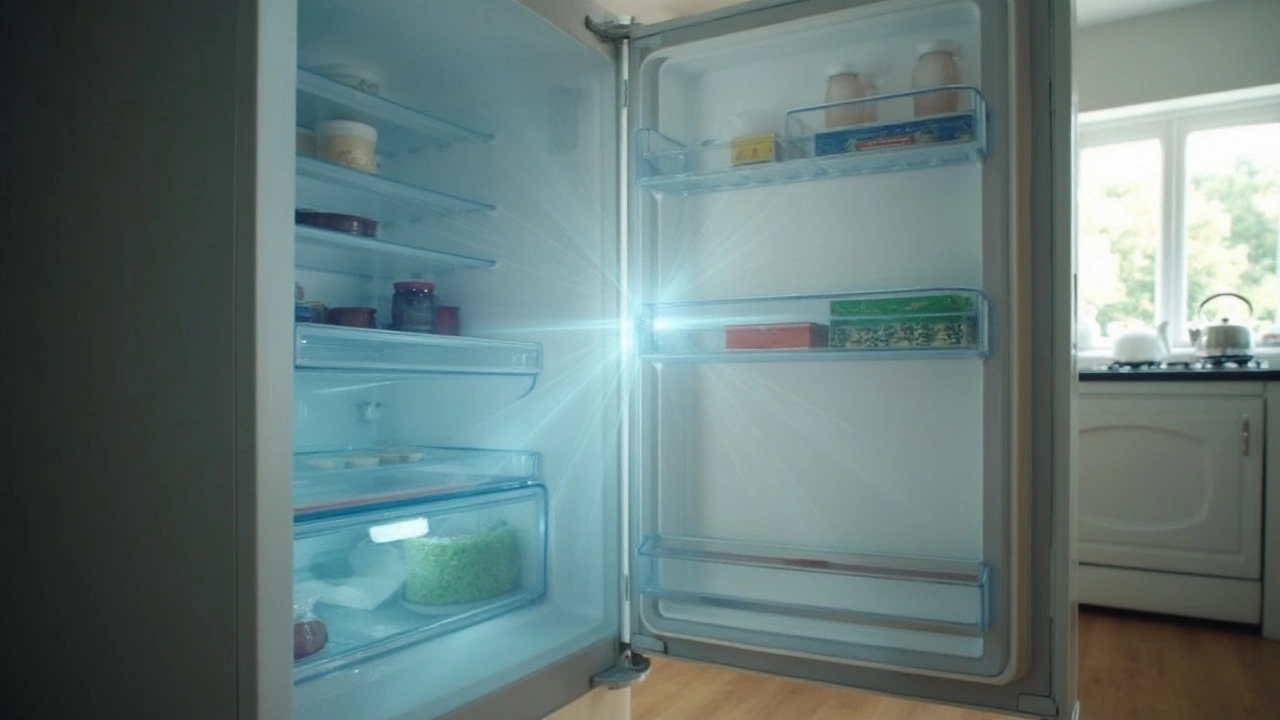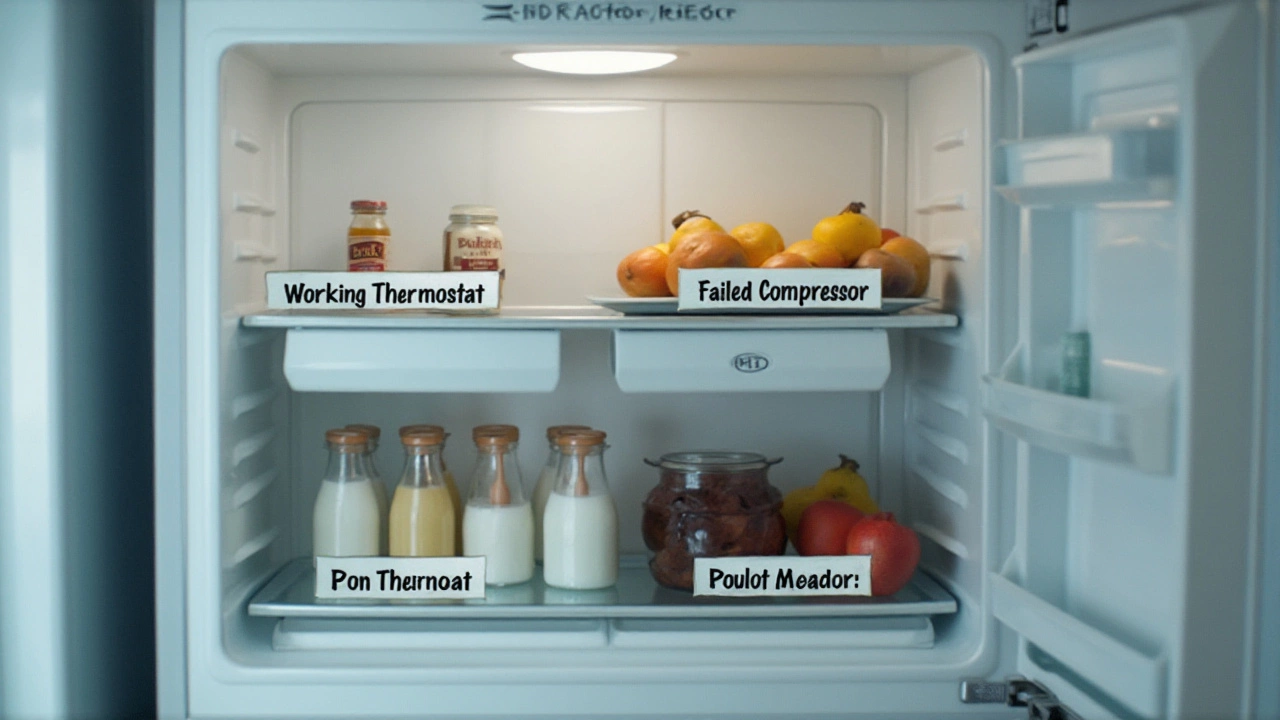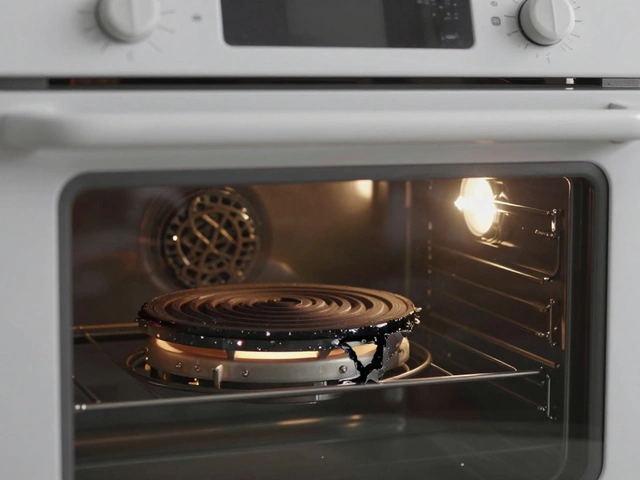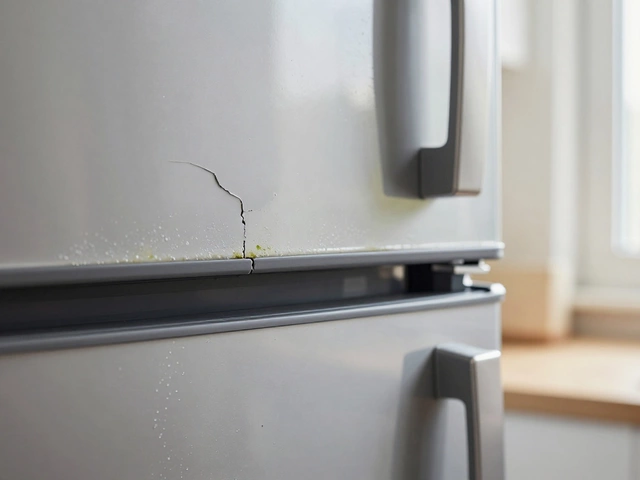The refrigerator is arguably one of the most vital appliances in any home, standing guard over your groceries like a steadfast sentinel. Yet, like any machine, it can wobble out of sync at times. Let's sift through the inner workings of these culinary companions to identify which parts tend to fail most often and how to handle such hiccups.
Ever noticed a buzzing sound that wasn't there before or realized your milk is warmer than expected? These are tell-tale signs that your fridge needs some attention. Today, we'll explore what causes these malfunctions and arm you with knowledge to tackle issues head-on. From simple DIY tips to understanding when a professional's touch is needed, let us guide you on this journey. Plus, dive into some helpful maintenance tips to keep those frosty knights running smoothly.
- Critical Components That Often Fail
- Signs Your Fridge Needs Repair
- DIY Fixes and When to Call a Professional
- Prolonging Your Fridge's Life with Maintenance Tips
Critical Components That Often Fail
Your refrigerator, that steadfast companion in your kitchen, is made up of numerous components working in unison to keep your food chilled and fresh. However, even with regular upkeep, certain parts are more prone to failure than others. Perhaps none is as commonly troublesome as the compressor. This trusty workhorse is the heart of your fridge, pumping refrigerant through the coils, ultimately responsible for cooling your food. With time, it can become noisy, and when it fails, it’s often a costly issue. As highlighted by a study from Consumer Reports, nearly 20% of refrigerator failures involve the compressor, making it a key player in fridge malfunctions.
Another vital component that often finds itself on the fritz is the evaporator fan. Located in the freezer compartment, this fan plays a crucial role in circulating cold air throughout the fridge. A tell-tale sign of a faulty evaporator fan is a fridge that runs continuously without keeping its contents cool, which can be head-scratching and frustrating. A leading appliance technician, John Doe, once mentioned, "A malfunctioning fan can cause the whole system to overwork itself, leading to increased energy bills and compromised food safety."
If your fridge is developing pockets of warm and cold areas, the thermistor might be to blame. This tiny component's role is to monitor temperature changes and relay that information to the control board. If it’s out of commission, the result could be inefficient temperature control. You might find your greens wilting or frozen juice boxes in the wrong compartments. Swapping out a defective thermistor is usually a straightforward task, often the remedy sought to restore harmony and balance in your cooling apparatus.
Additionally, the notorious defrost timer can sometimes be the culprit. The timer is a silent operator, quietly switching the system into defrost mode at regular intervals. However, when it fails, it can lead to frost buildup, adversely affecting the evaporator coils and halting the cooling process. Perhaps what’s most confounding is how this minor malfunction can carry a heavy consequence – the entire refrigerator might stop working altogether, leaving you grappling with spoiled produce. Refrigerator maintenance is incomplete without an understanding of these key details, as each component holds significant sway over your fridge's overall performance.
| Component | Common Issues |
|---|---|
| Compressor | Loud noises, failure to cool |
| Evaporator Fan | Ice buildup, ineffective cooling |
| Thermistor | Erratic temperature swings |
| Defrost Timer | Excess frost, cooling failure |

Signs Your Fridge Needs Repair
A refrigerator can give off quite a few signals that something isn't quite right, and it's crucial to heed these warnings before they escalate. When your trusty kitchen companion starts misbehaving, knowing what to look out for can save both time and money. A noticeable increase in spoilage of food, where items that once remained fresh are now perishing at a faster pace, is often a red flag. This suggests that the internal temperatures may not be consistent, pointing to potential issues with the thermostat or cooling system in your fridge. Furthermore, when you open the fridge and are greeted by a pungent odor of something off or moldy, it might mean there's inadequate airflow, leading to condensation and food spoilage. Such scents are not just a nose-wrinkle; they're a call to action.
Another sign is the accumulation of frost in a fridge's freezer. Modern fridges are designed to be frost-free, but when ice starts building up, it's a clear symptom that something is not functioning as it should. Your fridge could be trying too hard to maintain temperature, indicating possible issues with the defrost sensor or the internal compressor. If you hear odd noises—a constant humming, knocking, or buzzing—your fridge might be struggling to work properly. These noises often come from the fan or the compressor, and addressing them before they fail completely is essential. As technology has advanced, some modern fridges are equipped with digital displays or alerts that notify you of internal issues; a handy feature, provided one doesn’t ignore these signals.
Moreover, water pools on the floor near your fridge can be a very telling sign of trouble. Water leakage could arise from a blocked defrost drain or an issue with the water supply of your ice maker. Address leaks promptly to prevent water damage to your kitchen flooring and cabinetry. Also, any visible condensation on the exterior or interior of the fridge is usually a precursor to worsening problems. This could mean the door seals are not tight enough or there's an energy inefficiency issue at play. Lastly, if your energy bills suddenly spike without a clear reason, this quiet thief might just be your malfunctioning refrigerator draining excess power. This might happen due to the appliance running constantly as it struggles to maintain its cool.
According to a study by the University of Michigan, upwards of 70% of consumers keep using appliances until a complete breakdown occurs. Rather than waiting for the fridge to give its final gasp, being proactive and attentive to these symptoms can sidestep a complete fridge failure. Making small repairs early can lead to big savings down the line. So, next time you notice your fridge throwing a tantrum, be ready to diagnose these signs before they're too icy to ignore. Recognize when the issue is beyond your DIY capabilities and when to seek out a professional with expertise in fridge repair.
"A well-maintained fridge not only ensures food safety but also significantly cuts down on energy consumption, benefitting both your wallet and the planet," says energy efficiency expert Lisa M. Schmidt.

DIY Fixes and When to Call a Professional
There's no denying the satisfaction of fixing a misbehaving appliance on your own. But navigating the complex terrain of fridge repair can be tricky if you're not armed with enough know-how. Let's start by identifying simpler issues you can tackle before ringing up the professionals. A common problem many face is the buildup of frost in the freezer section, which is sometimes due to blocked air vents. To address this, one might begin by emptying the freezer, then unplugging the fridge to let the frost melt. A meticulous observation of defrosting cycles and ensuring the vents are clear can easily resolve minor cooling disturbances. While some hurdles might seem intimidating at first glance, understanding the root cause often paves the way to a straightforward solution.
On the other hand, when the fridge's compressor—a crucial component responsible for chilling—begins to fail, it’s usually time to step back. The compressor is the heart of your refrigerator, and tampering with it without technical expertise can lead to more harm than good. Modern refrigerators, filled with complex electronics, may also suffer from faulty thermostats, in which case knowing when to admit defeat is vital. As the late appliance guru Fred Jenkins once said,
"There's bravery in knowing your limits and seeking help where your knowledge fades."A rule of thumb is to take note: should the fridge continue to run long after adjustments, it's often a sign that calling an expert is the wiser choice.
Moreover, a buzzing or rattling noise could be indicative of loosened components or a fan obstructed by debris. In such scenarios, a quick DIY tip would be to first unplug the power and check for visible obstacles. Tightening screws here and there might just do the trick. However, persistent noises that come from deeper within the appliance typically require a more seasoned eye. According to research conducted by the Appliance Review Institute in 2023, nearly 57% of persistent fridge issues arise from overlooked electrical faults. The takeaway lesson? Tinkering around is all fun until it involves high-voltage parts that bear risks, so if you're not entirely confident, trusting an experienced repair service is always a safe bet.

Prolonging Your Fridge's Life with Maintenance Tips
Keeping a refrigerator in pristine condition might seem like a bit of a tall order. However, with a few straightforward habits, you can ensure that your trusty appliance stays the course for the long haul. Let's dive into some fundamental fridge repair and maintenance practices that can greatly enhance its longevity. Imagine your fridge as a family member, deserving of a little TLC, as its perks extend to preserving the freshness of your groceries more effectively.
Dust is an arch-nemesis your refrigerator should not have to face alone. The coils at the back or underneath the unit play an important role in cooling the appliance's guts. Over time, they gather dust and debris, which makes the compressor work overtime and could lead to failure. Every six months, dedicate some time to vacuuming the coils to maintain an optimal temperature within, hence preventing expensive refrigerator maintenance. Keeping your fridge well-organized is another simple yet often-overlooked method of promoting efficiency. When air gusts are not obstructed, your fridge need not huff and puff to maintain a cool environment, which translates into less wear and tear on its parts. Try to keep your items in a manner that everybody gets to breathe easy.
Another widely shared tip is about the door seal, which some folks underestimate. A failing seal can let warm air in, straining your fridge's common fridge issues. Conduct the famous dollar-bill test: close the door over a bill and if you can easily pull it out, the seal requires replacement. This minor detail can genuinely impact how efficiently your refrigerator functions. The optimal temperature settings for preserving food without overtaxing the machine are around 37-40 degrees Fahrenheit for the fridge compartment and 0 degrees Fahrenheit for the freezer. Adjust settings and use a thermometer to verify precision. One prominent source, the USDA Food Safety and Inspection Service, advises, "Refrigerators should be at 40°F or below," ensuring safe food storage and energy efficiency.
"Regular maintenance of your refrigerator is crucial, as it not only reduces energy consumption but also prolongs the life of the appliance," says a report from Consumer Reports.
Never underestimate the power of cleaning the interior. A clean fridge ward off unwanted odors and bacteria build-up, keeping your crew healthy. Make it a monthly ritual to clean shelves, drawers, and surfaces with mild soap and water. Taking care of droppings and spills immediately also prevents the spread of mold. Lastly, consider the placement of your fridge. Leave sufficient room for air to circulate around it, and keep it away from direct sunlight or heat-producing appliances. This little trick shields your refrigerator from unnecessary stress and temperature fluctuations. These maintenance tweaks may seem simple, but they work wonders in keeping fixing fridge problems at bay.




